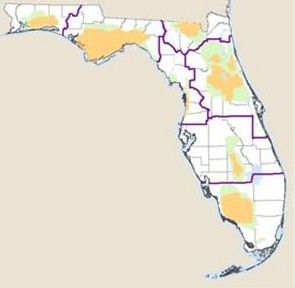The Florida black bear (Ursus americanus floridanus) is a minor predator of beehives in Florida with the potential to cause major destruction (Figures 1 and 2). Bears plunder beehives for the protein source provided by the brood, not necessarily to obtain the honey. Large-scale urban and agricultural development inexorably reduces prime bear habitat each year. This habitat often contains excellent bee forage, so bears and bees will sometimes come in contact, thus resulting in bear predation.

Credit: UF/IFAS Honey Bee Lab

Credit: UF/IFAS Honey Bee Lab
Black bears are located throughout much of Florida, but populations tend to be concentrated in specific areas. Major populations occur in southwest Florida (Collier, Hendry, and Monroe counties), Central Florida (Hernando, Pasco, and Citrus, Marion, Volusia, and Lake counties), northeast Florida (St. Johns, Columbia, and Baker counties), and in the southern panhandle (Franklin, Liberty, Gulf, and Bay counties). Bear populations usually correlate with large tracts of undisturbed habitat. Both heavy and moderate populations are noted in Figure 3. Please click on the image to be directed to FWC's current bear distribution map.

Credit: Florida Fish and Wildlife Conservation Commission (https://myfwc.com/)
Since 2001, most reports of bear depredation have come from the northern half of the state.
The best defense against bear damage to beehives is prevention. Colonies should be located as far as possible from known bear trails.
The two best and most reliable bear deterrents against beehive depredation are platforms and electric fences. Both methods of deterrent are IPM-friendly. Platforms are unquestionably effective, but are costly to build and often present bee management difficulties. Bear biologists at the Florida Wildlife Commission state that the use of electric fences are the primary reason for the large reduction in reports of bear depredated apiaries over the last decade. A well-maintained electric fence will keep most bears out of a bee yard if the colonies are placed inside after the fence is constructed. Once a bear has damaged colonies and learns the location of the food source, even electric fences often are not much help. Fences should have two or more "hot" wires, one eight inches off the ground, the other about forty inches high, with perhaps a third in the middle. Woven wire is suggested for an inside fence and a wire mat about two feet wide should be laid around the fence base. Both fencing and mat should be connected to the ground wire of the fence controller. You should consider using an electric fence if you keep bees in a location where bears are present (Figure 3).
Indemnity payment to beekeepers for bear damage does not exist in Florida. For more information on black bears in Florida, visit the Florida Fish and Wildlife Conservation Commission website (https://myfwc.com/wildlifehabitats/wildlife/bear/living/). Studies have shown that bears are opportunistic omnivores. This means they do not actively search out apiaries, but disturb them only when and if they find them. Bears, like humans, follow the course of least resistance. Thus, placing apiaries out of their path, away from established roads and watercourses, are good location strategies and are IPM friendly. Beekeepers having problems with bears should contact one of the five regional offices of the Florida Fish and Wildlife Conservation Commission (https://myfwc.com/). Nuisance bears can also be reported through the Wildlife Alert Hotline at 1-888-404-3922. It is important to remember that there are several state rules and regulations when dealing with bears and other wildlife. Always make sure to check with FWC before taking any action yourself.
Florida Black Bear Information
Black Bear/Honey Bee Publications
Brady, J.R., and D.S. Maehr. 1982. A new method for dealing with apiary-raiding black bears. Proceedings of Annual Conference of Southeastern Association of Fish and Wildlife Agencies 36:571–577.
Florida Fish and Wildlife Conservation Commission. 2001. Use of electric fencing to exclude bears and prevent property damage. Technical Information Bulletin, Florida Fish and Wildlife Conservation Commission, Tallahassee, Florida. 5 pp.
Maehr, D.S., J.R. Brady and J. Polk. 1982. "The bears and bees: seeking a solution." Florida Wildlife 35(6): 40–42.
Wooding, J.B., N.L. Hunter, and T.S. Hardisky. 1988. "Trap and release apiary-raiding black bears." Proceedings of Annual Conference of Southeastern Association of Fish and Wildlife Agencies 42: 333–336.